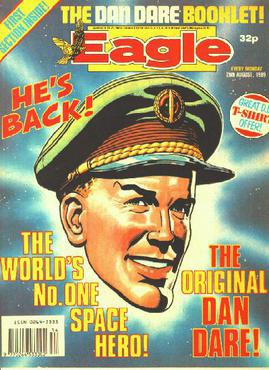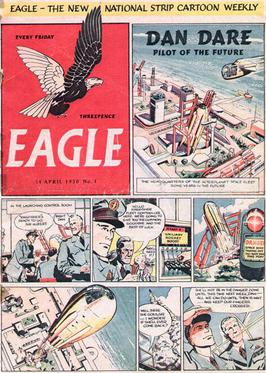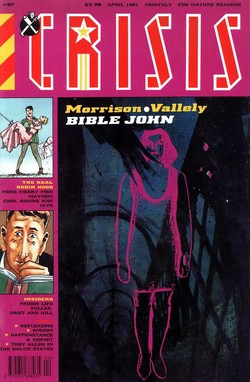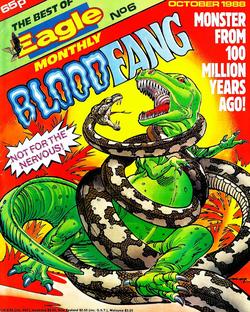
2000 AD is a weekly British science fiction-oriented comic magazine. As a comics anthology it serialises stories in each issue and was first published by IPC Magazines in 1977, the first issue dated 26 February. Since 2000 it has been published by Rebellion Developments.

Dan Dare is a British science fiction comic hero, created by illustrator Frank Hampson who also wrote the first stories. Dare appeared in the Eagle comic series Dan Dare, Pilot of the Future from 1950 to 1967, and dramatised seven times a week on Radio Luxembourg (1951–1956).

John Wagner is an American-born British comics writer. Alongside Pat Mills, he helped revitalise British comics in the 1970s, and continues to be active in the British comics industry, occasionally also working in American comics. He is the co-creator, with artist Carlos Ezquerra, of the character Judge Dredd.

Eagle was a British children's comics periodical, first published from 1950 to 1969, and then in a relaunched format from 1982 to 1994. It was founded by Marcus Morris, an Anglican vicar from Lancashire. Morris edited a Southport parish magazine called The Anvil, but felt that the church was not communicating its message effectively. Simultaneously disillusioned with contemporary children's literature, he and Anvil artist Frank Hampson created a dummy comic based on Christian values. Morris proposed the idea to several Fleet Street publishers, with little success, until Hulton Press took it on.

Crisis was a British comic anthology published by Fleetway Publications from 17 September 1988 to October 1991, initially fortnightly and later monthly. Designed to appeal to older readers than other Fleetway titles in order to take advantage of a boom in interest in 'adult' comics, Crisis featured overtly political and complex stories; one issue was even produced in conjunction with Amnesty International.
The Mekon of Mekonta is the arch-enemy of the British comic book hero Dan Dare. He first appeared on 3 November 1950 in the 30th episode of the Eagle comic strip Dan Dare, Pilot of the Future, having been created by Frank Hampson. Apart from Dan Dare himself, he is the only character to appear in every one of the numerous versions of the comic strip that appeared in the Eagle, 2000 AD and Virgin Comics. In the 1950s, roughly every other story featured the Mekon.
Judge Dredd: The Megazine is a monthly British comic magazine, launched in September 1990. It is a sister publication to 2000 AD. Its name is a play on words, formed from "magazine" and Judge Dredd's locale Mega-City One.

"The Thirteenth Floor" is a British science fiction strip character, appearing in titles published by IPC Magazines. The strip debuted in the weekly anthology Scream! on 24 March 1984, before continuing in Eagle until 28 February 1987. The stories were written by John Wagner and Alan Grant; art was provided by José Ortiz. Since 2016 the property has been owned by Rebellion Developments, who have revived the strip in several specials. The plot was set in a tower block called Maxwell Tower, controlled by an experimental sentient computer called Max located on the 13th floor of the flats. Max himself narrated the strip, and as befitting a computerised custodian of hundreds of people, was quite chatty and light-hearted. However, he was also portrayed as having a programming flaw; programmed to love and protect his tenants, he could remorselessly kill anyone who threatened or even just annoyed them.

"The House of Daemon" is a horror British comic strip, appearing in titles published by IPC Magazines. The story was published in the anthology Eagle from 11 September 1982 to 12 February 1983, written by John Wagner and Alan Grant, with art by José Ortiz. The story followed couple Elliot and Cassandra Aldrich, who moved into a new home - only to find it is haunted by a demonic being.
Chris Weston is a British comics artist who has worked both in the US and UK comics industries.
Rian Hughes is a British graphic designer, illustrator, type designer, comics artist and novelist.
Steve Yeowell is a British comics artist, well known for his work on the long-running science fiction and fantasy weekly comic 2000 AD.
Duncan Fegredo is a British comic book artist.

Revolver was a British monthly comic anthology published by Fleetway Publications from July 1990 to January 1991. The comic was designed as a monthly companion title to Crisis and was intended to appeal to older readers than other Fleetway titles in order to take advantage of a boom in interest in 'adult' comics. Revolver was not a commercial success, and lasted just seven issues before being cancelled and merged with Crisis.
Brendan McCarthy is a British artist and designer who has worked for comic books, film and television. He co-wrote the film Mad Max: Fury Road. He is the brother of Jim McCarthy.

Lion was a weekly British comics periodical published by Amalgamated Press from 23 February 1952 to 18 May 1974. A boys' adventure comic, Lion was originally designed to compete with Eagle, the popular weekly comic published by Hulton Press that had introduced Dan Dare. It debuted numerous memorable characters, including Captain Condor, Robot Archie, Paddy Payne and the Spider. Lion lasted for 1,156 issues before being merged with stablemate Valiant.

"Bible John - A Forensic Meditation" is a creator-owned British comic story. It was originally published in the adult-orientated comic Crisis between May and August 1991. Written by Grant Morrison with art by Daniel Vallely, the story is a multimedia study of the unsolved Bible John murders carried out in Glasgow in the 1968 and 1969.

Bloodfang is a British comic character, appearing in strips published by IPC Magazines. The character featured in British comic stories published in the weekly anthology Eagle from 9 June 1984 to 30 March 1985, written by John Wagner and Alan Grant and drawn by Jim Baikie, Carlos Cruz González and Vanyo. The story followed the eponymous tyrannosaurus rex, initially in prehistoric times and then later in the year 2150.

Eagle, sometimes referred to as The New Eagle and known at various points in its life as Eagle and Scream!, Eagle and Tiger, Eagle and Battle, Eagle and M.A.S.K. and Eagle and Wildcat, was a British boys' adventure comic published by IPC Magazines from 27 March 1982 to January 1994. A revival of the famous Eagle, the title was initially a weekly publication until turning into a monthly in May 1991. The title was finally cancelled in January 1994, after 505 issues.












